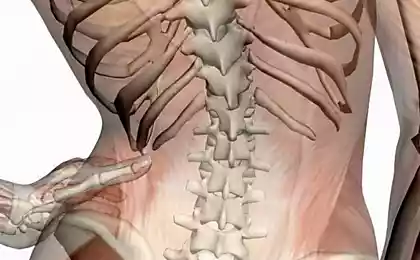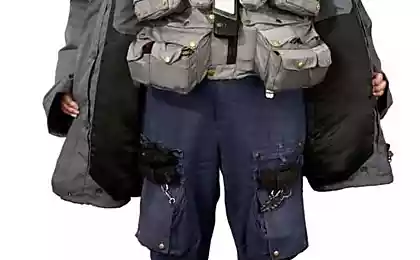224
4 exercises to correct the anterior pelvic inclination
Anterior pelvic inclination is one of the most common postural dysfunctions. It is easy to see by looking at the person from the side. 2 main visual landmarks: a large difference between the height of the anterior and posterior iliac bones and excessive lumbar lordosis.

What is the anterior slope of the pelvis? The pelvis is the structure that connects the trunk and legs. The main movements of the pelvis are rotations and inclinations. With the anterior inclination of the pelvis, lumbar lordosis will increase, the hip joints will begin to bend.
To determine if you have an anterior pelvic tilt, stand with your back close to the wall and measure the distance between your waist and wall. With the “normal curvature” of the lumbar, the space between it and the wall should let your hand through. In men, the anterior slope is normally 4-7 degrees, in women 7-10. If the distance between the wall and the hand is thicker than your palm, then it is likely that your pelvis is in the front tilt.
The shortening of the muscles of the thigh flexors can cause such dysfunction. Such shortening can occur as a result of prolonged sitting, improper training, injuries. When such a person stands up, the shortened muscles pull the pelvis into the anterior slope, causing an increase in lumbar lordosis.
There are currently no studies proving a direct link between excessive lumbar lordosis and low back pain. But there is research showing a limitation of extension, internal and external hip rotation in patients with chronic, nonspecific back pain. We all know that when the flexion of the thigh is limited, lumbar lordosis will increase compensatoryly. Working in general, with a complex thigh-pelvis-lumbar, we can significantly help the patient.
From an aesthetic point of view, the anterior inclination of the pelvis does not carry any special advantages, since the stomach in this case will appear larger than it actually is.

Exercises to correct the anterior inclination of the pelvis There are several components that must be acted upon to return the pelvis to its original position.
• Shortened thigh flexors;
• Weak abdominal muscles;
• Tension of the lumbar muscles;
• Weak gluteal muscles.
During the practice, I chose four exercises to correct the anterior pelvic inclination. One for each of the above items. These exercises are effective both for stretching some muscles and for strengthening others. They are easy to do because they do not require special equipment.
Exercise 1: Increase the length of the hip flexor muscles This is an exercise to increase the length of the thigh flexors. Try to maintain tension in the abdominal muscles and buttocks during this exercise.
1. Get on your right knee. The left leg will stand on the foot. In professional terminology, this position is called – on the knee and foot.
2. Swing your whole body forward, move until you feel a pulling sensation along the front surface of the thigh (closer to the hip area). Avoid increasing lumbar lordosis.
3. The sensations of stretching should not be extremely intense. Hold the fixation for 3 to 5 minutes on each side.
4. In order to increase the impact on the more distal quadriceps fibers, bend the back leg at the knee joint. This can be done by putting something under the ankle joint or putting your foot on the wall.
Exercise 2: Lower straight legs without taking your back off the floor1. Start lying on your back with straight legs raised. Press your lower back to the floor.
2. Lower both legs down, keeping your knees straightened until the lower back starts to come off the floor.
3. Return to the starting position and make 2 sets of 20 repetitions.
Keeping your back pressed against the floor is very important. If the back is detached from the floor, this means that the abdominal muscles stop working, and instead, the already tense thigh flexors begin to work excessively. It can be helpful to hold your hand between the lower back and the floor to make sure you keep your back pressed against the floor. As the strength of the abdominal muscles will increase, you will be able to lower your legs below, without tearing the waist off the floor.
Exercise 3: Bridge with leg straightening 1. Lie on your back. Bend both legs at the knee joints.
2. Raise your pelvis as high as possible. The shoulders must remain on the floor.
3. While in this position, straighten one leg and linger for 5 seconds.
4. Return this leg to its original position and do the same with the other leg.
5. After that, return to the starting position and make 2 sets of 10 repetitions.
This exercise trains your buttocks, gamstrings and muscle control of the anterior abdominal wall. During the exercise, there should be no rotation of the body and / or bending in the hip joint, support leg.
Exercise 4: Rotating the pelvis backward Exercise is very important. It is necessary to perform this exercise standing, because it is in this position that dysfunction occurs. The ability to control the position of the pelvis in a standing position is an important factor in improving posture.
1. Stand with your back against the wall, heels on the width of the shoulders.
2. Press the lower back against the wall as well as the hips and shoulders. The knees should be straight.
3. Hold in this position for ten seconds and then relax. Repeat 10 times.
During this exercise, the abdominal muscles and gluteal muscles are activated. For control, you can place your hand between the back and the wall. This position of the hand will determine how well you perform the movement. The second hand can be placed on the stomach, this will allow you to feel the work of the muscles of the anterior abdominal wall.
When performing this exercise, remember your feelings, you will need them during the day.
In conclusion, the correct position of the pelvis is important for our health. This allows you to optimize the motor stereotype and relieve those regions that already work excessively. Maintaining this position throughout the day allows you to achieve stable results of postural correction. published
Author: Leonid Kutuzov
P.S. And remember, just changing our consumption – together we change the world!
Join us on Facebook, VKontakte, Odnoklassniki
Source: yodaga.com/profile/leonid/pages/8146

What is the anterior slope of the pelvis? The pelvis is the structure that connects the trunk and legs. The main movements of the pelvis are rotations and inclinations. With the anterior inclination of the pelvis, lumbar lordosis will increase, the hip joints will begin to bend.
To determine if you have an anterior pelvic tilt, stand with your back close to the wall and measure the distance between your waist and wall. With the “normal curvature” of the lumbar, the space between it and the wall should let your hand through. In men, the anterior slope is normally 4-7 degrees, in women 7-10. If the distance between the wall and the hand is thicker than your palm, then it is likely that your pelvis is in the front tilt.
The shortening of the muscles of the thigh flexors can cause such dysfunction. Such shortening can occur as a result of prolonged sitting, improper training, injuries. When such a person stands up, the shortened muscles pull the pelvis into the anterior slope, causing an increase in lumbar lordosis.
There are currently no studies proving a direct link between excessive lumbar lordosis and low back pain. But there is research showing a limitation of extension, internal and external hip rotation in patients with chronic, nonspecific back pain. We all know that when the flexion of the thigh is limited, lumbar lordosis will increase compensatoryly. Working in general, with a complex thigh-pelvis-lumbar, we can significantly help the patient.
From an aesthetic point of view, the anterior inclination of the pelvis does not carry any special advantages, since the stomach in this case will appear larger than it actually is.

Exercises to correct the anterior inclination of the pelvis There are several components that must be acted upon to return the pelvis to its original position.
• Shortened thigh flexors;
• Weak abdominal muscles;
• Tension of the lumbar muscles;
• Weak gluteal muscles.
During the practice, I chose four exercises to correct the anterior pelvic inclination. One for each of the above items. These exercises are effective both for stretching some muscles and for strengthening others. They are easy to do because they do not require special equipment.
Exercise 1: Increase the length of the hip flexor muscles This is an exercise to increase the length of the thigh flexors. Try to maintain tension in the abdominal muscles and buttocks during this exercise.
1. Get on your right knee. The left leg will stand on the foot. In professional terminology, this position is called – on the knee and foot.
2. Swing your whole body forward, move until you feel a pulling sensation along the front surface of the thigh (closer to the hip area). Avoid increasing lumbar lordosis.
3. The sensations of stretching should not be extremely intense. Hold the fixation for 3 to 5 minutes on each side.
4. In order to increase the impact on the more distal quadriceps fibers, bend the back leg at the knee joint. This can be done by putting something under the ankle joint or putting your foot on the wall.
Exercise 2: Lower straight legs without taking your back off the floor1. Start lying on your back with straight legs raised. Press your lower back to the floor.
2. Lower both legs down, keeping your knees straightened until the lower back starts to come off the floor.
3. Return to the starting position and make 2 sets of 20 repetitions.
Keeping your back pressed against the floor is very important. If the back is detached from the floor, this means that the abdominal muscles stop working, and instead, the already tense thigh flexors begin to work excessively. It can be helpful to hold your hand between the lower back and the floor to make sure you keep your back pressed against the floor. As the strength of the abdominal muscles will increase, you will be able to lower your legs below, without tearing the waist off the floor.
Exercise 3: Bridge with leg straightening 1. Lie on your back. Bend both legs at the knee joints.
2. Raise your pelvis as high as possible. The shoulders must remain on the floor.
3. While in this position, straighten one leg and linger for 5 seconds.
4. Return this leg to its original position and do the same with the other leg.
5. After that, return to the starting position and make 2 sets of 10 repetitions.
This exercise trains your buttocks, gamstrings and muscle control of the anterior abdominal wall. During the exercise, there should be no rotation of the body and / or bending in the hip joint, support leg.
Exercise 4: Rotating the pelvis backward Exercise is very important. It is necessary to perform this exercise standing, because it is in this position that dysfunction occurs. The ability to control the position of the pelvis in a standing position is an important factor in improving posture.
1. Stand with your back against the wall, heels on the width of the shoulders.
2. Press the lower back against the wall as well as the hips and shoulders. The knees should be straight.
3. Hold in this position for ten seconds and then relax. Repeat 10 times.
During this exercise, the abdominal muscles and gluteal muscles are activated. For control, you can place your hand between the back and the wall. This position of the hand will determine how well you perform the movement. The second hand can be placed on the stomach, this will allow you to feel the work of the muscles of the anterior abdominal wall.
When performing this exercise, remember your feelings, you will need them during the day.
In conclusion, the correct position of the pelvis is important for our health. This allows you to optimize the motor stereotype and relieve those regions that already work excessively. Maintaining this position throughout the day allows you to achieve stable results of postural correction. published
Author: Leonid Kutuzov
P.S. And remember, just changing our consumption – together we change the world!
Join us on Facebook, VKontakte, Odnoklassniki
Source: yodaga.com/profile/leonid/pages/8146























